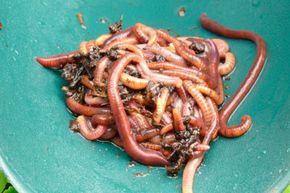Quck answer
Earthworms are invertebrate animals that live in soil and play an important role in the ecosystem. They help to aerate the soil and break down organic matter, making nutrients more available to plants. Earthworms have a segmented body with a head and tail end. They move through soil by contracting and expanding their muscles, aided by tiny bristles called setae. Earthworms are hermaphrodites, meaning they have both male and female reproductive organs. They mate by exchanging sperm, and then lay eggs in cocoons. Earthworms can regenerate lost segments, and some species can even reproduce asexually.
Animal Information
Earthworm Breeding

Earthworm reproduction or just unfortunately tangled up?
iStockphoto/Thinkstock
The sexuality of earthworms is one of the most fascinating aspects. Earthworms are simultaneous hermaphrodites, which means they have both male and female reproductive organs. During sexual intercourse, both worms use both sets of sex organs. If all goes well, the eggs of both mates become fertilized, which is an extremely efficient method of ensuring the survival of the species. Vermicomposters, who raise worms and other organisms for compost, report that their earthworm populations usually double every 60 to 90 days [source: Werner].
To mate, two earthworms align themselves against each other facing opposite directions. In this position, both worms secrete so much mucus that a slime tube forms around their bodies. Each worm ejaculates sperm from its sex organs into the slime tube, and it is then deposited in the other worm’s sperm receptacle. The mating process is complete, but the reproduction process continues as each worm goes its separate way [source: Conrad].
The clitellum, the wide band near the front of any earthworm, is responsible for producing another tube of mucus. This band is passed forward toward the mouth end of the worm. As it travels forward, the mucus passes over the sacs containing the worm’s own eggs, which stick to the slime. Attached to the slime tube, the eggs then pass over the seminal receptacle, where the other worm’s sperm is kept. The eggs and sperm come in contact in the slime tube, and if all goes well, the eggs are then fertilized.
The band of slime is wriggled off the head of the worm and forms a cocoon in the shape of a lemon for the anywhere from four to 20 worm eggs that the common European earthworm typically lays. In about two to three weeks, the newborn worms will hatch and emerge from the cocoon into the soil. This cycle of reproduction can occur every week to ten days, which is another reason why earthworm populations can grow so quickly [source: Barrett].
If necessary, earthworms can also reproduce themselves. They can regenerate new segments if they lose a few. Most earthworms are better at regenerating tails than heads, but some can regenerate both. However, they don’t reproduce asexually; only half (and likely the head half) of an earthworm split in two will regenerate into a full worm once again [source: Tomlin].
FAQ
1. What are earthworms?
Earthworms are segmented invertebrates that belong to the phylum Annelida and the class Oligochaeta. They are commonly found in soil and play an important role in soil health by breaking down organic matter and improving soil structure.
2. How do earthworms reproduce?
Earthworms are hermaphrodites, meaning they have both male and female reproductive organs. They mate by aligning their bodies and exchanging sperm, which fertilizes each other’s eggs. The fertilized eggs are then laid in a cocoon, which the earthworm secretes from its own body.
3. What do earthworms eat?
Earthworms are detritivores, meaning they feed on dead organic matter such as leaves, grass, and other decaying plant material. They also consume soil, which helps to break down the organic matter and release nutrients for plants to absorb.
4. How do earthworms help soil health?
Earthworms help to improve soil health in a number of ways. They burrow through the soil, which helps to create channels for air and water to flow through. They also break down organic matter, which releases nutrients into the soil and improves soil structure. Additionally, earthworms create castings, which are nutrient-rich deposits of soil that are beneficial for plant growth.
5. How do earthworms breathe?
Earthworms breathe through their skin, which is moist and allows oxygen to diffuse into their bodies. They also need to stay moist in order to prevent their skin from drying out, which can be harmful to their health.
6. How long do earthworms live?
The lifespan of an earthworm varies depending on the species, but most live for several years. Some species can live for up to 10 years or more.
7. What predators do earthworms have?
Earthworms are preyed upon by a variety of animals, including birds, moles, shrews, and other small mammals. They are also vulnerable to certain types of insecticides and other chemicals that are used in agriculture.
8. How do earthworms move?
Earthworms move by contracting and relaxing their muscles, which allows them to stretch and contract their bodies. They also use their setae, or bristles, to grip the soil and move forward. This movement helps to aerate the soil and create channels for air and water to flow through.





Leave a Reply